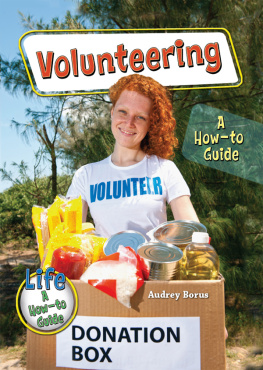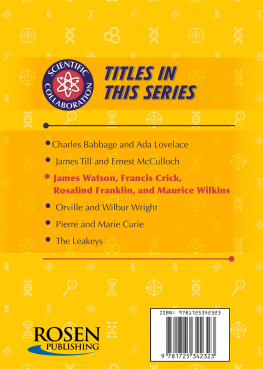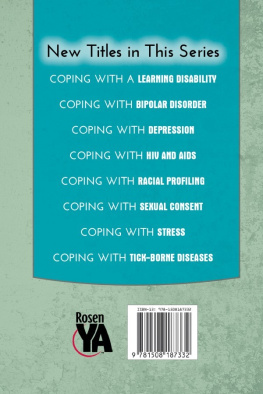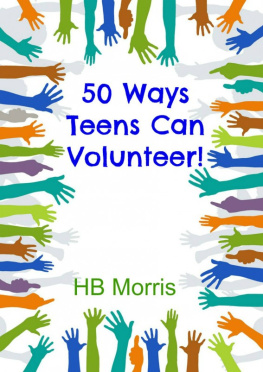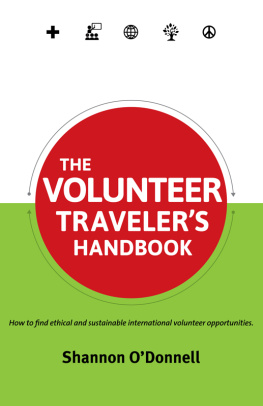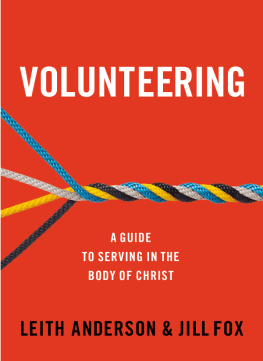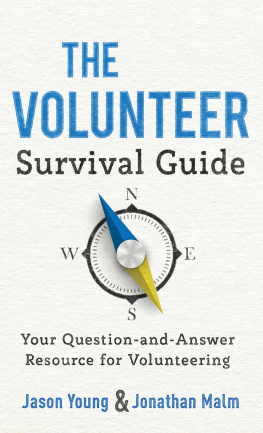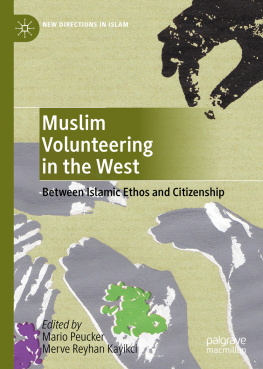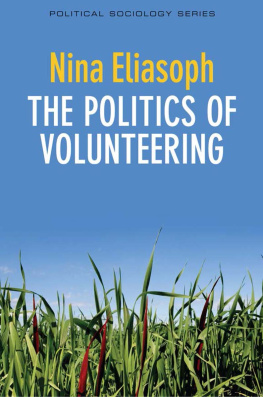Audrey Borus - Volunteering. A How-to Guide
Here you can read online Audrey Borus - Volunteering. A How-to Guide full text of the book (entire story) in english for free. Download pdf and epub, get meaning, cover and reviews about this ebook. year: 2012, publisher: Enslow Publishers, genre: Politics. Description of the work, (preface) as well as reviews are available. Best literature library LitArk.com created for fans of good reading and offers a wide selection of genres:
Romance novel
Science fiction
Adventure
Detective
Science
History
Home and family
Prose
Art
Politics
Computer
Non-fiction
Religion
Business
Children
Humor
Choose a favorite category and find really read worthwhile books. Enjoy immersion in the world of imagination, feel the emotions of the characters or learn something new for yourself, make an fascinating discovery.
- Book:Volunteering. A How-to Guide
- Author:
- Publisher:Enslow Publishers
- Genre:
- Year:2012
- Rating:5 / 5
- Favourites:Add to favourites
- Your mark:
- 100
- 1
- 2
- 3
- 4
- 5
Volunteering. A How-to Guide: summary, description and annotation
We offer to read an annotation, description, summary or preface (depends on what the author of the book "Volunteering. A How-to Guide" wrote himself). If you haven't found the necessary information about the book — write in the comments, we will try to find it.
Are you interested in helping others, or are you looking for new ways to get involved in your school or community? VOLUNTEERING: A HOW-TO GUIDE is an easy-to-read introduction to the world of volunteering. Discover what types of volunteer work you would enjoy most, and find out different ways to get started.
Audrey Borus: author's other books
Who wrote Volunteering. A How-to Guide? Find out the surname, the name of the author of the book and a list of all author's works by series.
Volunteering. A How-to Guide — read online for free the complete book (whole text) full work
Below is the text of the book, divided by pages. System saving the place of the last page read, allows you to conveniently read the book "Volunteering. A How-to Guide" online for free, without having to search again every time where you left off. Put a bookmark, and you can go to the page where you finished reading at any time.
Font size:
Interval:
Bookmark:
Give a Helping Hand
Volunteering is a great way to help make a positive change toward an issue you feel passionate about. But how do you get involved? Learn about different ways to volunteer and get inspired by stories of other teens who have made positive changes in their communities. Explore the different issues and organizations with this informative how-to guide.
About The Author
Audrey Borus is a librarian who lives in Massachusetts. She has also written A Student's Guide to Emily Dickinson for Enslow Publishers, Inc.


Opportunities to improve your community are all around you. If you want to make a positive change, you may find opportunities for community service in the most unlikely places. Take for example, the kids at the 4-H Model Horse Club in Salmon, Idaho. Their interest in horses led them to a community service project helping horses on Turtle Bay Island in the Bahamas.
The Model Horse Clubs story actually starts centuries before, when Christopher Columbus first landed in the New World. In addition to everything else, he brought horses with him that could help in exploration and colonization.
Today, eight special horses, descendants of the Spanish horses who first traveled to the Americas in the 1400s, live on a tiny strip of land called Turtle Bay Island. It is one of the seven hundred islands that make up the Bahamas. Historians and horse buffs believe they are there because the Caribbean was an important place for these Spanish travelers. They set up breeding stations for their horses and exported them to the colonies in North and South America. In the process, many ships transporting the horses were wrecked on the islands of the Caribbean. Todays horses are called the Abaco Barbs, and they are believed to be the descendants of a herd that once may have numbered two hundred. They represent a marvel of nature: transcending time, the elements, and the creep of development.
When Susan Dudasik told the kids from the Salmon Model Horse Club that these horses were near extinction, the kids knew they wanted to do something. But their first thought was, What can we do? Were only kids. Cameron Angeny, one of the kids in the group, said:
The club didnt really need to be convinced to do something. I guess due to Susans enthusiasm we all wanted to help the horses. I had read a book named Jingo: Wild Horse of Abaco by Jocelyn Arundel. My Mom and I were discussing what we could possibly do for the horses, and she mentioned getting a Breyer model of Misty and the book Misty of Chincoteague when she was little. I wondered if I could get Breyer involved somehow and get them to sell Jingo and an Abaco Barb model and donate part of the proceeds to the Abaco Barb horses.
Cameron brought the idea to the club. The kids brain-stormed and developed a plan.They petitioned Breyer Animal Creations about developing a model Abaco Barb horse that would help raise awareness about them. Breyer was impressed. The company created the new line in 2005 and donated a portion of their profits to Arkwild, an organization dedicated to preserving the horses.
Cameron says he learned a lot from this project. For example, he says, Not all endangered species are starving, or have the same problems as one another.
Today, in spite of some setbackssuch as fires and drought in May 2010new forage for the horses is slowly growing and more areas in which they can roam have been fenced.
Asked whether he had advice for young volunteers like himself, Cameron answered:
You can make a difference in the world. You dont have to go overseas to make a difference; you can do it from home. I would encourage young people to try and make a difference and improve the world. We need to be aware of our environment. Im not saying we shouldnt build houses or anything, but I think its good to be aware. Make sure that you arent deliberately, or unnecessarily, harming the environment. It is a balance, and the environment is going to have to change as a result of people just living and progressing. But dont be afraid of trying to make a difference!
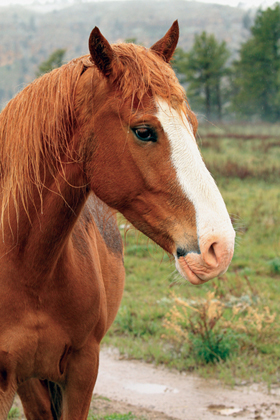
The 4-H Model Horse Club in Salmon, Idaho, volunteered their efforts to support a group of endangered horses.
So what exactly is volunteering? All definitions of volunteering include the following four elements:
- Volunteering is voluntary; you do it because you choose to.
- You dont get a financial reward for volunteering; essentially, you donate your time and talents.
- You perform your volunteer work through a formal arrangement (such as with a nonprofit organization, a government agency, a school, or a business) or through an informal arrangement, such as helping neighbors or friends.
- Your volunteering benefits others: people in need, your community, and even you.
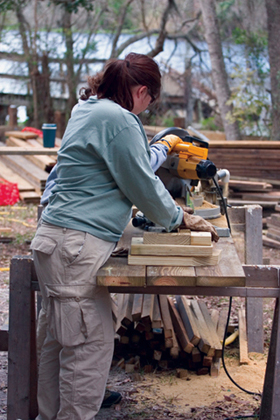
A teen volunteer saws planks for a boardwalk in a wildlife park in Blue Springs State Park, Florida. Nearly 16 million kids under age eighteen are volunteers.
Volunteering is a helpful activity. By helping someone less fortunate, you may feel better about your life. It may also move you to consider a variety of other ways that you can help others. True volunteering is something you plan to do, maybe even before someone asks you to. And it requires some commitment of your time and your energy.
Right now in the United States, about 26 percent of the population is under age eighteenthat is about 70 million people. About 15.5 million kids under eighteen are youth volunteers. They are people like you, who spend money, have thoughts and opinions, and care about things. In the United States, a typical youth volunteer contributes about twenty- nine hours per year. That may not sound like a whole lot for the time span of an entire year, but these young people are making many significant contributions to their communities.
All kinds of organizations offer opportunities for you to volunteer. In fact, you may already know about some of them through your school. Or you may be required to take a course in which you spend some time providing a service to your community (such as visiting residents at a nursing home) and some of your time in class evaluating your volunteer experience. The latter is called service learning, and while volunteering is a major part of it, identifying the new skills and knowledge that you are gaining is also important. Through service learning, you learn about an issue or problem, figure out an appropriate action, then apply your skills to help solve that problem. For example, if you volunteer at a homeless shelter, you may go back to class to learn about the issues surrounding homelessness and its causes. You could also look at what some U.S. cities are doing to help the homeless. This process allows students to practice their communication skills by learning how to explain the problem and learning how to communicate with the people they are helping.
Another type of volunteering is available through youth leadership organizations, such as 4-H, Boy Scouts, or Girl Scouts. These organizations emphasize volunteering, rather than formal learning. But that is not to say you wont be learning anything, its just that there are most likely no specific learning objectives as there are in a class. For example, depending on your individual experience, volunteering may help you develop leadership skills or teach you how to think more broadly about a community issue.
Font size:
Interval:
Bookmark:
Similar books «Volunteering. A How-to Guide»
Look at similar books to Volunteering. A How-to Guide. We have selected literature similar in name and meaning in the hope of providing readers with more options to find new, interesting, not yet read works.
Discussion, reviews of the book Volunteering. A How-to Guide and just readers' own opinions. Leave your comments, write what you think about the work, its meaning or the main characters. Specify what exactly you liked and what you didn't like, and why you think so.

